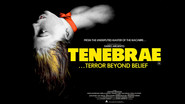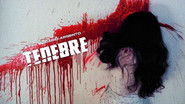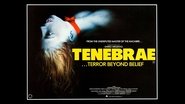grahamcarter-1
The Christian religious service of 'Tenebrae' involves the gradual extinguishing of candles, while a series of readings and psalms is recited; Matins and Lauds.In 'Tenebre', there are two separate characters who suffer from impaired vision. Detective Giermani tells writer Peter Neal that he is a big fan of "Agatha Chrisite, Spillane and Ed McBain…" however he goes on to reveal that he has never been able to solve the identity of the killer in any of their stories. This continues into real life as the corpses pile up with Neal standing in plain sight. Neal with a traumatic event in his youth hinted at, responds to a series of murders by becoming a killer himself. He introduces the theme of impaired vision when he admits to Giermani: "I've tried to figure it out, but I just have this hunch that something is missing, a tiny piece of the jigsaw. Somebody who should be dead is alive, or somebody who should be alive is already dead." Of course Neal, who is promoting his latest book 'Tenebrae,' is the 'missing piece,' and in the end he will become the 'somebody who should be dead.' In flashback a sadistic temptress is stabbed to death; this acts as the catalyst for the murders in the film. In the present day, the first victim is a sexually promiscuous shoplifter, and the next two are the lesbian reporter and her bisexual lover. The flashbacks are introduced repeatedly throughout the course of the film, usually immediately following a murder. The first reveals a beautiful young woman's sexual bullying of a teenage boy (whom we later presume is Neal). The second is a revenge-murder of the same woman. There is a doubling between Neal and Giermani, as Giermani reflects Neal even as Neal takes on his role as investigator. The detective/writer and the writer/detective each belittle the other. In what is one of the best pieces of 'shock' ever put on celluloid, Neal and Giermani become one (momentarily) when Neal memorably dispatches the Detective; "in a shot that is as schematically logical as it is logically outrageous" (McDonagh). The reveal of the killer as the hero bends down was borrowed from Argento's own 'The Bird with the Crystal Plumage', as is the climactic murder by art in which Dalmas was trapped beneath a large pointed sculpture.Although 'tenebrae'/'tenebre' means 'darkness' or 'shadows,' Argento tasked his cinematographer Luciano Tavoli with filling the screen with as much light as possible. Tavoli had worked on 'Suspiria', and had also worked with Antonioni on 'Chung Kuo-China' (1972), 'The Passenger' (1975), and the first feature shot on video 'The Mystery of Oberwald' (1981). The day scenes are brightly lit, and the interiors harshly over lit; the film is shot with clear 'cold' light, permeating the surroundings. He was deliberately breaking with the legacy of German Expressionism.Fritz Lang's Beyond a Reasonable Doubt (1956) comes to mind when considering Argento's influences; film-noir at its most paranoid often finds Lang not far away. '…doubt' finds a man convicted of murder on false evidence who in fact is guilty of the crime. Roy William Neill's legendary film- noir Black Angel (1946) is even more remarkable, where a man tries to clear a murder suspect, but doing so will be at the cost of learning that he himself is the killer. An argument could be made for 'Tenebre' being one of the most important 'non-Hitchcock' films De Palma has seen; the 'Louma' crane sequence is clearly a key influence right down to the music in 'The Untouchables' (1987). More obvious still is the 'Raising Cain' surprise reveal of the killer standing behind the victim. Robert Zemeckis' 'What Lies Beneath' (2000) contains a similar moment, although Zemeckis has denied having any familiarity at all with Italian 'Giallo'… more's the pity.Successful and released without incident in Europe, 'Tenebre' was classified, prosecuted and banned as a 'video nasty' in the U.K, and the film had five minutes of 'sexualised violence' cut prior to its theatrical release. Its U.S distribution was delayed for two years, then only in a heavily censored version under the title 'Unsane.' Approximately ten minutes shorter, losing scenes that established the characters and their relationships that make it difficult to follow, it received a mostly negative critical reception.Critic and Argento expert Maitland McDonagh has described 'Tenebre' (as opposed to 'Unsane'), as "the finest film that Argento has ever made."
thelastblogontheleft
For starters, this is definitely not my favorite Dario Argento film, but DAMN is the soundtrack amazing. The main theme, composed by Goblin (who have collaborated with Argento many times), is just… so good. It manages to be tense and dramatic, a bit sinister, but also super dancey. It's perfect.Tenebre (also written as Tenebrae, and also known as Unsane, which is the heavily edited/cut version that was released to the US) follows American murder-mystery author Peter Neal (Anthony Franciosa) on his extended trip to Rome to promote his newest book, Tenebre. His arrival coincides with a string of brutal murders, with the killer inspired by Neal himself (and sending him letters to let him know as much, referring to him as "The Great Corrupter"). The police ask for Neal's help in solving the crimes, involving him in a deeply disturbing and personal quest.True to any of Argento's films, this movie is striking to watch. Close attention is paid to color, light, shadow, symbolism, and the incredible cinematography (thanks to Luciano Tovoli). Absolutely a movie that you could watch more than once and notice something new on each subsequent viewing.Also true to classic Argento style, many of the most memorable scenes revolve around killing. You often don't know much, or anything, about the victims before their demise, so it's hard to feel anything but fascination when they're finally executed. But closeups of the victims' eyes, clever framing, the closeup of the straight razor breaking the light bulb, the woman falling backwards through the glass door, a freshly chopped arm spraying blood across a white wall… all brilliant.The most brilliant of all might be the crane shot outside of the home of the lesbian couple. It's several minutes of just slow, crawling shots moving up and down the outside walls… it's not even intended to be from the killer's perspective, obviously, but just this lingering, creeping shot, giving you a very voyeuristic feeling, a sort of invasion of something that seems at first glance to be private and secure.Tenebre was Argento's return to the giallo subgenre, and he himself has alluded to it being a sort of taunting of his critics, some of which were referring to him as a misogynist or a sadist. He wanted to include all of these aspects from his previous films — sexuality, murder, mystery — to kind of be a way of addressing his own public image, to challenge those around him, to show his "dark side".It, naturally, leaves you in a state of suspense and mystery for most of the movie — you're wondering and guessing and trying to solve the crimes as they unfold — only to have something like FOUR rapid fire twists in the last 20 minutes or so. It's insane. Plus the other favorite shot of mine — when Peter Neal is revealed as Detective Germani bends down. Perfect (and unplanned — they just happened to notice how similar their sizes and builds were during shooting), and goes hand-in-hand with the reoccurring themes of doppelgängers and reflections throughout the film.Like I said, not Argento's best, in my opinion, but absolutely a stunning thrill ride!
Mark Turner
Over the past few months I've come to appreciate the genre of horror films known as giallo more than I did in the past. While I'd seen several of the movies long ago I never quite got what the whole interest in them was. I get it now. It's a style, the way a story is told, the images that combine with those to make a compelling movie. I've discovered movies I missed and gone back to revisit some I saw long ago. TENEBRAE falls into that latter category.Anthony Franciosa stars as Peter Neal, an author who specializes in horror filled tomes revolving around murder. In Italy to promote his latest book he suddenly finds himself in the midst of a real life serial killing situation. It seems that the killer must be a fan as he's murdering people similar to the styles used in Neal's books and stuffing pages from his books in their mouths.As the film moves forward more questions come to mind. Is the killer someone influenced by the work of Neal or is it actually Neal himself doing the killing? What tie with Neal does the killer have, a personal connection or just that of crazed fan? Who will the next victim of the killer be and do all the victims have something in common? All is revealed by the end with something most viewers won't see coming.First off let's start with the acting. There isn't an actor in the bunch here who doesn't turn in a fine performance. Franciosa, a regular on numerous television series in the sixties and seventies, does a fantastic job as Neal, giving him that investigative edge when it comes to trying to solve the identity of the murderer while at the same time presenting himself as a likely suspect. A nice trick if you can pull it off and he does so quit well. John Saxon, a man who starred in what is considered the first giallo film, is on hand as well doing a great job as Neal's agent. The other actors also turn in great performances though I'm honestly not as familiar with their previous work, the only exception of which is Daria Nicolodi who has starred in several giallo works and was also the longtime companion of director Dario Argento.Dario Argento. Among the directors most noted for creating and giving life to this genre, Argento is the one who made it more mainstream than ever and who led it from simple murder mysteries into the realm of horror with supernatural touches in several films. He takes the various elements of the genre, the black gloved hands, the violent deaths, the bright colors and camera angles and makes them his own. The blood spilled in Argento's films always flows bright red and bursts forth more so than earlier examples of the genre and yet in an artistic way that doesn't force you to turn your head. His style is truly recognizable and puts him among the greats of film history.As I said, I've watched films in this genre in the past and TENEBRAE is one of those films. I even recall having it in the video store I once owned, a new release that I was sure fans would embrace. But it never really quite caught on in my area and neither did the whole giallo genre. Even I wasn't quick to embrace it but at least I recognized it existed. In part that might have been because the quality of the movies at the time left much to be desired. It wasn't that they were terrible but still, the transfers were usually soft focused and dubbing was terrible. That all changed with DVD and more so now with blu-ray. When coupled with the treatment of this film by Synapse it gets even better.Synapse has released a new version of the film on blu that is something to behold. The quality, the clarity, the crispness of the image is amazing. This new version features a supervised color correction and restoration of a 1080p scan from the original camera negative, presented in the original aspect ratio of 1.85:1. What that means is the best quality picture to watch that has ever been offered.In addition to that there are a number of other extras worth noting. There is a commentary track by film critic and Argento expert Maitland Mcdonagh. The blu-ray version includes a feature length documentary, YELLO FEVER: THE RISE AND FALL OF THE GIALLO by High Rise Productions discussing the rise in popularity of the genre from its early roots in crime fiction and on through its influence on slasher films into the world today. Also included are the original end credits sequence from the films U.S. version title UNSANE, alternate opening credits and an international trailer. Synapse is doing a great job with the way they're handling releases like this and it makes fans and movie lovers grow anxious to see what they have next in store. Right now they're taking orders for another Argento film, PHEOMENA, and I for one can't wait to see what they do with it. If nothing else I'm certain that we'll get the best looking version of the film, another among those I once saw in low quality VHS. With the care they're showing to the films of Argento it just makes you wish they could be responsible for handling all of his films.
archie_stanton
As a long time Argento fan I have seen most of his work, but for some reason this film has been off my radar until recently. I have to say though after a recent viewing (I have now seen it twice), this may be a masterwork. Susperia and Deep Red may have street credit, but for my money, THIS is the one that is the true giallo.It keeps the viewer wound up until the end. It is TRUE suspense. I am a grown man, who has seen all matter of exploitation, but true tension takes skill and that is exactly what Argento delivers in Tenebre. As the film moves on the suspense and levels build so high as the mystery of the whodunit unravels I literally had to get up and take a peepee break. If you are a fan of Argento and haven't seen this you must now. Also fans of Hitchcock and De Palma would be interested.The film is a high wired dance of the macabre. With excellent photography as usual from this bunch, featuring a 2 and half minute tracking shot which took 3 days to film. There are occasional times when plot elements seem far fetched, but that's a giallo for you. You have to suspend very little disbelief to enjoy this one, and when you do, you are thrust right into the jaws of an angry barking dog. See this.
















